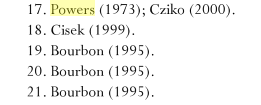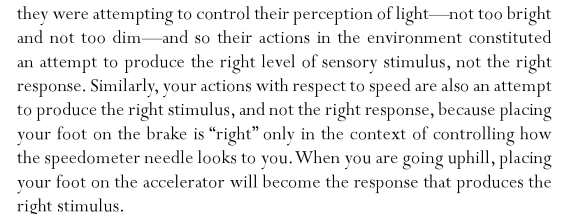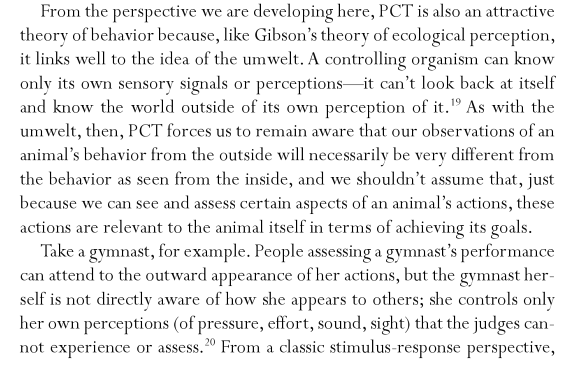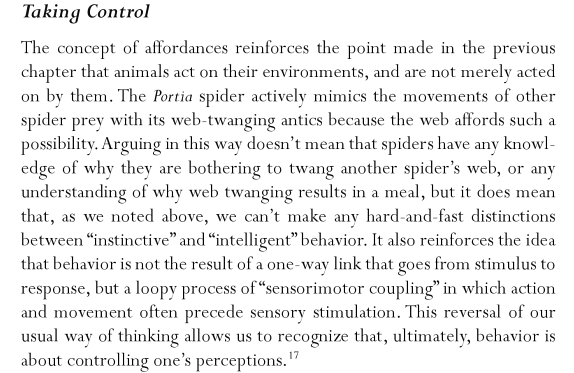···
From:
Warren Mansell
[mailto:wmansell@gmail.com]
Sent: maandag 5 november 2012
11:54
To: Bruce Nevin; bruce.nevin@gmail.com
Cc: Control Systems Group Network
(CSGnet); Hugh Petrie; Hugh Gibbons; Henry Yin; Tim Carey;
fplooij@kiddygroup.com; Sara Tai; Warren Mansell;
Tom Bourbon; Karin Forssell; Bart Madden; Mohammad Goli; Bjorn Leffler; Monica
Leffler; Lisa Forssell; Bruce Abbott; Gary Cziko; Alice Powers McElhone; Lloydk
Klinedinst; Dick Robertson; mathwerkx@yahoo.com; j richard kenneway; Dag
Forssell
Subject: Re: video of presentation
at Stanford February 2012
Hi Bruce, this is great to see, and I really like the level of detail
you go into Bruce! It is now linked from pctweb on the psychology page.
I watched the questions afterwards too.
I think it is important to maybe correct what you said about
publication. It may be hard to get PCT stuff published but this makes us sound
fringe. We are not. Most of the good empirical work on PCT is published. See
the downloadable
working document I have produced.
I think there is a balancing act to do between validating some of the
similarities between PCT and Gibson, at the same time as being very clear about
the differences too. I think the student is being too opinionated to say that
the equations are ‘exactly the same’ - this could not be established from such
a comparison based on his memory and viewing your talk - it would need to be
analysed in much more detail.
We commonly get the argument that PCT is the same as this or that
theory - and it is a really hard one to counter, I think because there are so
many components to compare. We can’t just say PCT is completely different and
they just can’t say it is the same. There needs to be a thorough, systematic
analysis.
Great stuff and thanks for the link!
Warren
On Sun, Nov 4, 2012 at 3:34 AM, Bruce Nevin bnhpct@gmail.com wrote:
Last February, I gave a talk to a colloquium at Stanford, called
the “Stanford Psychology and Language Tea”, a.k.a. SPLaT. Dag
has given a lot of support to my work and to my currently in-process career
change back to linguistics. On this occasion he was videographer and provided
copies of a bunch of books for the attending faculty and students to see, some
of which they could take and keep.
The presentation aims to introduce this audience of psychologists and
linguists to PCT. It focuses on the solution to a puzzle that emerged in some
recent experimental work in which speakers’ auditory perception of what they
said was disturbed in real time. A proposed PCT model indicates a solution to
the puzzle. We discussed this on CSGnet some years ago. A working simulation
has not yet been built. (Assistance with this would be welcome.)
The video, edited to include the slides, is at http://www.livingcontrolsystems.com/SPLaT/SPLaT_Nevin.html. Previously,
I had been unable to get either of the two researchers (Shira Katseff and John
Houde) to reply to email, but when I was in Berkeley last February I met John Houde, who
is now at UCB, and he was friendly and interested in seeing my presentation, so
I will now send him the link.
In the video, there’s a plug for Frans Plooij’s work and a plug for
Rick’s baseball demo. In the Q&A there are some suggestions as to where we
might be more successful at getting PCT research published. The student who
makes these suggestions (now graduated and a newly minted professor elsewhere)
takes the Gibsonians to mean, not that information is in the environment, but
that the organism and the environment are tightly coupled in a way that is
expressed by integration of simultaneous equations in just the manner that we
do in PCT. (IMO they equivocate, but being tactful about this, and approaching
the correction of it gradually, might indeed open some publication
opportunities.)
I may not see comments on this in a timely way unless you send them (or
include a cc) to bruce.nevin@gmail.com.
/Bruce
–
Dr Warren Mansell
Reader in Psychology
Cognitive Behavioural Therapist & Chartered Clinical Psychologist
School of Psychological Sciences
Coupland I
University of Manchester
Oxford Road
Manchester M13
9PL
Email: warren.mansell@manchester.ac.uk
Tel: +44 (0) 161 275 8589
Website: http://www.psych-sci.manchester.ac.uk/staff/131406
The next spring BABCP conference will take place in Belfast from 4th to 5th April 2013. The BABCP
Annual Conference will take place from 16th July - 19th July 2013 at Imperial College,
University of London. For further information as it
appears, see www.babcpconference.com.
See teamstrial.net for
further information on our trial of CBT for Bipolar Disorders in NW England
For further information on the ESRC Emotion Regulation of Others and the
Self Network Grant, please see: www.erosresearch.org
The highly praised therapy manual on Transdiagnostic CBT using Method of Levels is available
from November 2012.
Check www.pctweb.org for
further information on Perceptual Control Theory





